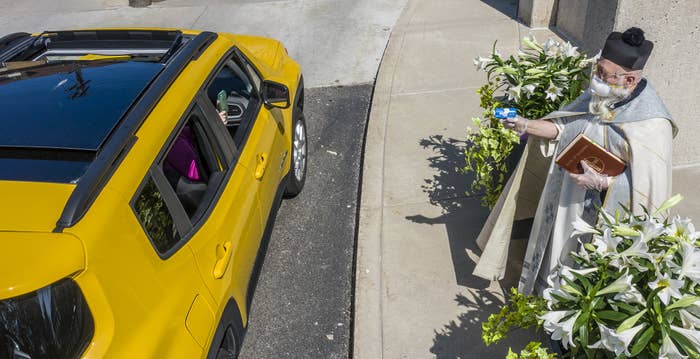Ashley Collman MAY 16, 2020
Workers in masks and gloves at a USPS processing and distribution center in Oakland, California, on April 30, 2020. None of the workers pictured in this article are in the story.
Ben Margot/AP
On April 30, the United States Postal Service said that it had "updated our leave policies to allow liberal use of leave" during the coronavirus pandemic.
The reality looks very different. Some employees say they are finding it very hard to take sick leave, even if they have been exposed to someone with COVID-19.
Business Insider spoke to two USPS mail carriers, who said managers are making workers jump through hoops to take time off. The USPS has not responded to a request for comment.
On April 30, the United States Postal Service said that it had "updated our leave policies to allow liberal use of leave" during the coronavirus pandemic.
The reality looks very different. Some employees say they are finding it very hard to take sick leave, even if they have been exposed to someone with COVID-19.
Business Insider spoke to two USPS mail carriers, who said managers are making workers jump through hoops to take time off. The USPS has not responded to a request for comment.
One carrier in Massachusetts said his coworker, who had direct contact with a coronavirus patient, was told he could go back to work.
Another carrier in California said he had not been paid for 14 days he recently took off after his coworker tested positive. He was feeling sick, and that his bosses are now ignoring him.
Despite the United States Postal Service's assurances that employees will be allowed "liberal" sick leave during the coronavirus pandemic, mail carriers say their bosses are making it incredibly difficult for them to take time off.
Business Insider spoke to two mail carriers, in California and Massachusetts, who detailed similar experiences. Both requested to remain anonymous to avoid retribution, but their identities are known to Business Insider.
The carrier in California, who works in a station outside Stockton, said he has yet to be paid for the 14 days he recently took off after a coworker tested positive for the coronavirus and he started feeling sick himself.
Meanwhile, the carrier in Massachusetts — who has worked for the service for 33 years — spoke of another employee who was told to come back to work after he was exposed to an infected customer.
USPS claims 'liberal' time off being allowed
These stories are at odds with the April 30 statement put out by the USPS, which said employees would not have a hard time taking sick days during the pandemic.
A United States Postal Service (USPS) worker works in the rain in Manhattan during the coronavirus outbreak in New York City. Reuters
According to the statement, the service had "updated our leave policies to allow liberal use of leave and to therefore give our employees the ability to stay home whenever they feel sick, must provide dependent care, or any other qualifying factor under the Families First Coronavirus Response Act."
"We have entered into agreements with our unions to provide 80 hours of paid leave to non-career employees for issues related to COVID-19, and have expanded the definition of sick leave for dependent care for covered employees to deal with the closures of primary and secondary schools across the country," the statement added.
Told to return after exposure to COVID-19
The Massachusetts carrier told Business Insider one of his coworkers had decided to go home after learning he was exposed to an infected customer.
While that coworker was on the phone to his doctor, trying to figure out what to do, he received a call from a manager at the station saying he could return to work.
"He wanted to get the opinion of his medical professional ... and they were literally trying to get him to turn around and go back to work," the carrier told Business Insider.
"It was just an awful situation."
The coworker decided to stay at home and self-quarantine after speaking to his doctor, who had said, "absolutely do not go back to work."

According to the statement, the service had "updated our leave policies to allow liberal use of leave and to therefore give our employees the ability to stay home whenever they feel sick, must provide dependent care, or any other qualifying factor under the Families First Coronavirus Response Act."
"We have entered into agreements with our unions to provide 80 hours of paid leave to non-career employees for issues related to COVID-19, and have expanded the definition of sick leave for dependent care for covered employees to deal with the closures of primary and secondary schools across the country," the statement added.
Told to return after exposure to COVID-19
The Massachusetts carrier told Business Insider one of his coworkers had decided to go home after learning he was exposed to an infected customer.
While that coworker was on the phone to his doctor, trying to figure out what to do, he received a call from a manager at the station saying he could return to work.
"He wanted to get the opinion of his medical professional ... and they were literally trying to get him to turn around and go back to work," the carrier told Business Insider.
"It was just an awful situation."
The coworker decided to stay at home and self-quarantine after speaking to his doctor, who had said, "absolutely do not go back to work."
A USPS employee in Manhattan during the coronavirus pandemic. Mike Segar/Reuters
The Massachusetts carrier said while he has not requested any time off during the pandemic, he knows the USPS is making it incredibly difficult.
"They really push for documentation. You gotta jump through a couple hoops before they check the box," he said.
He says the USPS has always been this way.
"They've never been very considerate about sick leave," he said. "My experience through the years up until now is that if you call in sick, they question what's wrong."
"They're not supposed to, but they do. It's a small guilt trip."
Waiting to get paid
The California carrier said his managers made it very difficult for him to get paid sick leave when he took time off after being exposed to an infected coworker, and experiencing symptoms himself. It took place recently, around the same time as the April 30 statement.
He said the day after he learned about the coworker getting sick, he came down with a mild fever, fatigue, and started showing redness in his legs and eyes.
So he decided to call in sick, both to recuperate and to make sure he didn't accidentally transmit the coronavirus to anyone if he had contracted it.
He was immediately told that in order to get paid sick leave, he would need a doctor's note. Because he doesn't have health insurance, he paid out of pocket to see a doctor and get a note.

The Massachusetts carrier said while he has not requested any time off during the pandemic, he knows the USPS is making it incredibly difficult.
"They really push for documentation. You gotta jump through a couple hoops before they check the box," he said.
He says the USPS has always been this way.
"They've never been very considerate about sick leave," he said. "My experience through the years up until now is that if you call in sick, they question what's wrong."
"They're not supposed to, but they do. It's a small guilt trip."
Waiting to get paid
The California carrier said his managers made it very difficult for him to get paid sick leave when he took time off after being exposed to an infected coworker, and experiencing symptoms himself. It took place recently, around the same time as the April 30 statement.
He said the day after he learned about the coworker getting sick, he came down with a mild fever, fatigue, and started showing redness in his legs and eyes.
So he decided to call in sick, both to recuperate and to make sure he didn't accidentally transmit the coronavirus to anyone if he had contracted it.
He was immediately told that in order to get paid sick leave, he would need a doctor's note. Because he doesn't have health insurance, he paid out of pocket to see a doctor and get a note.
A USPS letter carrier crosses a quiet Boylston Street with greatly reduced foot and vehicle traffic in Boston on March 18, 2020. Lane Turner/The Boston Globe via Getty Images
After self-isolating at home for about two weeks, the carrier said he checked his employee profile online and saw that he still wasn't being paid for his sick leave.
He has since been told that his doctor's note specifically needed to have a coronavirus diagnosis on it, he said.
This, in turn, has been almost impossible.
"I tried calling the doctor back and he said two things: One, the CDC for six weeks now is asking doctors not to give out any notes at all because it's a waste of valuable time and resources; and two, they would never write your medical details down on a note as those are private," he said.
'A toxic environment from the top down'
Since returning to work this week, the California carrier said his bosses have been avoiding him, and he is not hopeful that he will ever get paid for taking that time off.
"I know 100% they're going to fight tooth and nail just to ignore me," he said.
Hygiene at his station has also been dire. In a previous interview with Business Insider, he described a lack of masks, social distancing, and having to stand "nearly shoulder to shoulder with everyone all the time" at his station.
He has become so fearful of the conditions there he's even resorted to looking for a new job.
"It's the worst possible time, but I'm already looking for other positions," he said. "They don't have my back. They don't have anybody's back at this point."
"It looks like a toxic environment from the top down."
The USPS has not responded to Business Insider's request for comment.
After self-isolating at home for about two weeks, the carrier said he checked his employee profile online and saw that he still wasn't being paid for his sick leave.
He has since been told that his doctor's note specifically needed to have a coronavirus diagnosis on it, he said.
This, in turn, has been almost impossible.
"I tried calling the doctor back and he said two things: One, the CDC for six weeks now is asking doctors not to give out any notes at all because it's a waste of valuable time and resources; and two, they would never write your medical details down on a note as those are private," he said.
'A toxic environment from the top down'
Since returning to work this week, the California carrier said his bosses have been avoiding him, and he is not hopeful that he will ever get paid for taking that time off.
"I know 100% they're going to fight tooth and nail just to ignore me," he said.
Hygiene at his station has also been dire. In a previous interview with Business Insider, he described a lack of masks, social distancing, and having to stand "nearly shoulder to shoulder with everyone all the time" at his station.
He has become so fearful of the conditions there he's even resorted to looking for a new job.
"It's the worst possible time, but I'm already looking for other positions," he said. "They don't have my back. They don't have anybody's back at this point."
"It looks like a toxic environment from the top down."
The USPS has not responded to Business Insider's request for comment.











